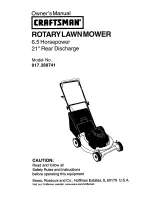
17
Bagging Wet Grass
Do not mow on slopes when grass is wet. Always try to
cut grass when it is dry because your lawn will have a neat
appearance. Wet grass on level surfaces can be mowed
using the conventional side discharge feature of the
mower. Several hours later, when the clippings are dry,
install the complete bagger attachment and vacuum up the
grass clippings.
Signs of Plugging
As you are bagging, a small amount of grass clippings
normally blow out the front of the mower. An excessive
amount of clippings blowing out indicates that the bags
are full or the system is plugged.
Maintenance
Debris built up in the engine compartment, if not
removed, could be ignited by a hot engine. A fire
in the engine compartment could can burn you
and others and can damage property.
•
Before using and while the engine is cool, check
for debris in the engine compartment.
•
Keep the machine free of grass, leaves, or other
debris build-up.
•
Clean up oil or fuel spillage and fuel soaked
debris.
•
Allow the machine to cool before storing.
Warning
Note:
Determine the left and right sides of the machine
from the normal operating position.
Inspecting the Bagger
Attachment
Inspect the bagger attachment after the first 10 hours of
operation, and monthly thereafter.
1.
Check the blower, discharge tube, and the bagger top.
Replace these parts if they are cracked or broken.
2.
Tighten all nuts, bolts, and screws.
3.
Inspect the grass bags for deterioration.
You or bystanders could be severely injured by
flying debris or thrown objects that may pass
through torn, worn, or deteriorated grass bags.
•
Frequently check the grass bags for holes, rips,
wear, and other deterioration.
•
Do not wash the grass bags.
•
If the bag has deteriorated, install new grass
bags supplied by the manufacturer of this
bagger attachment.
Warning
Inspecting the Mower Blades
1.
Inspect the mower blades regularly and whenever a
blade strikes a foreign object.
2.
If the blades are badly worn or damaged, install new
blades. Refer to your
Operator’s Manual
for complete
blade maintenance.
Caring for the Grass Bags
Washing the grass bags is not recommended.
To prevent rapid deterioration of the bag material, store
the bags where they will dry completely after each use.
Cleaning the Bagger
Attachment
1.
After each use, remove and wash the inside and
outside of the bagger top, discharge tube, blower, and
the underside of the mower, using water sprayed from
a garden hose. Use a mild automotive detergent to
remove stubborn dirt.
2.
Make sure you remove matted grass from all parts.
3.
After washing, let all of the parts dry thoroughly. Do
not wash the grass bags.
Storing the Bagger Attachment
1.
Clean the bagger attachment; refer to Cleaning the
Bagger Attachment, page 17.
2.
Inspect the bagger attachment for damage; refer to
Inspecting the Bagger Attachment, page 17.
3.
Make sure the grass bags are empty and thoroughly
dry.
4.
Store the bagger in a clean, dry place, out of direct
sunlight. This protects the plastic parts and extends the
life of the bagger. If you must store the bagger outside,
cover it with a weatherproof cover.




































